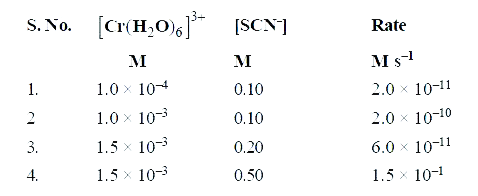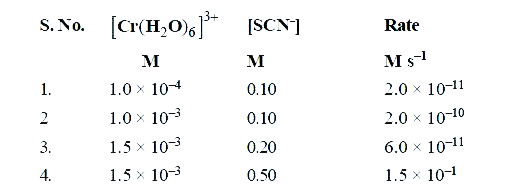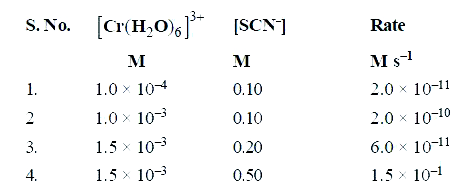For the following data at 25∘C
Cr3+(aq)+1¯e→Cr2+(aq),E∘=−0.424V, Cr2+(aq)+2¯e→Cr(s),E∘=−0.900V Find E∘ at 25∘ for the reaction:
Cr3++3¯e→Cr(s)Solution in Punjabi
−0.741V
−1324V
−0.476V
+0.741V
Step by step video & image solution for For the following data at 25^@CCr^(3+)(aq)+1barerarrCr^(2+)(aq),E^@=-0.424V, Cr^(2+)(aq)+2barerarrCr(s),E^@=-0.900V Find E^@ at 25^@ for the reaction:Cr^(3+)+3barerarrCr(s) by Chemistry experts to help you in doubts & scoring excellent marks in Class 12 exams.
Updated on:21/07/2023Topper's Solved these Questions
- ELECTROCHEMISTRYBOOK - MODERN PUBLICATIONCHAPTER - ELECTROCHEMISTRYEXERCISE - EXERCISE
529 Videos
- d-AND f- BLOCK ELEMENTSBOOK - MODERN PUBLICATIONCHAPTER - d-AND f- BLOCK ELEMENTSEXERCISE - EXERCISE
1089 Videos
- GENERAL PRINCIPLES AND PROCESSES OF ISOLATION OF ELEMENTSBOOK - MODERN PUBLICATIONCHAPTER - GENERAL PRINCIPLES AND PROCESSES OF ISOLATION OF ELEMENTSEXERCISE - EXERCISE
303 Videos
Similar Questions
The resistance of a 0.25 mol or solution of an molar solution of an electrolyte was found to be 75Ω. Calculate the molar conductivity of the solution if the electrods in the cell are 1.8 cm a part and having an area of cross section 3.6cm2.
View SolutionName the third and fourth transition elements of first transition series.
View SolutionTrue of False : Copper is found both in free as well as in combined state in nature.
View SolutionGiven the standard reduction potentials, which statement is correct?
Cu2(aq)+2e−→Cu(s)E∘=0.34V2H+(aq)+2e−→H2(g)E∘=0.0VCr3+(aq)+2e−→Cr(s)E∘=−0.73V
View SolutionWhat is the approximate value of the equilibrium constant, K_(eq) , at 25^(@) C for the reaction, 3Ag^(+)(aq) + Cr(s) rightarrow Cr^(3+)(aq) + 3Ag(s)
View Solutionwhat is the standard electrode potential for the reduction of HClO?
HClO(aq)+H+(aq+2e−→Cl−(aq)+H2O(l)
Given: Cr2(aq)→Cr3+(aq)+e−,E∘=0.41V
HClO(aq)+H+(aq)+2Cr2+(aq)→2Cr3+(aq)+H2O(l),E∘=1.80
View SolutionThe measured voltage for the reaction with the indicated concentration is 1.50 V. Calculate E∘.
Cr(s)+3Ag+(aq,0.10M)→3Ag(s)+Cr3+(aq,0.30M)
View SolutionThe E^(@) at 25^(@) for the following reaction at the indicated concentration is 1.50 V. Calculate the DeltaG in kJ at 25^(@) C: Cr(s)+3Ag^(+)(aq,0.1M) rarrAg(s)+Cr^(3+)(aq,0.1M)
View SolutionIn the cell , Cr(s) | Cr^(3+)(aq) || Cd^(2+)(aq) | Cd(s) ., write down the anodic and cathodic reactions and also overall reaction.
View SolutionThe standard reduction potentials at 298K for the following half cells are given : ZN^(2+)(aq)+ 2e^(-)Zn(s) , E^(@) = - 0.762V Cr^(3+)(aq)+ 3e^(-) Cr(s) , E^(@) = - 0.740V 2H^(+) (aq)+2e^(-) H_(2)(g) , E^(@)= 0.000V Fe^(3+)(aq)+ e^(-) Fe^(2+)(aq) , E^(@) = 0.770V which is the strongest reducing agent ?
View SolutionThe reaction [Cr(H2O)6]3+(aq)+SCN−(aq)→[Cr(H2O)5NCS]2+(aq)+H2O(l) was studied at 25∘C. The following date ware collected.

Determine : Order of each reactant.
View SolutionThe reaction [Cr(H2O)6]3+(aq)+SCN−(aq)→[Cr(H2O)5NCS]2+(aq)+H2O(l) was studied at 25∘C. The following date ware collected.

Determine : Rate law.
View SolutionThe reaction [Cr(H2O)6]3+(aq)+SCN−(aq)→[Cr(H2O)5NCS]2+(aq)+H2O(l) was studied at 25∘C. The following date ware collected.

Determine : Rate constant of the reaction.
View SolutionThe E∘ at 25∘C for the following reaction at the indicated concentrations is 1.50 V . Calculate the ΔG in kJ at 25∘C,Cr(s)+3Ag+(aq.0.1M)→Ag(s)+Cr3+(aq.0.1M)
View Solutionwhat is the standard electrode potential for the reduction of HClO?
HClO(aq)+H+(aq+2e−→Cl−(aq)+H2O(l)
Given: Cr2(aq)→Cr3+(aq)+e−,E∘=0.41V
HClO(aq)+H+(aq)+2Cr2+(aq)→2Cr3+(aq)+H2O(l),E∘=1.80
View SolutionThe measured voltage for the reaction with the indicated concentration is 1.50 V. Calculate E∘.
Cr(s)+3Ag+(aq,0.10M)→3Ag(s)+Cr3+(aq,0.30M)
View Solution
